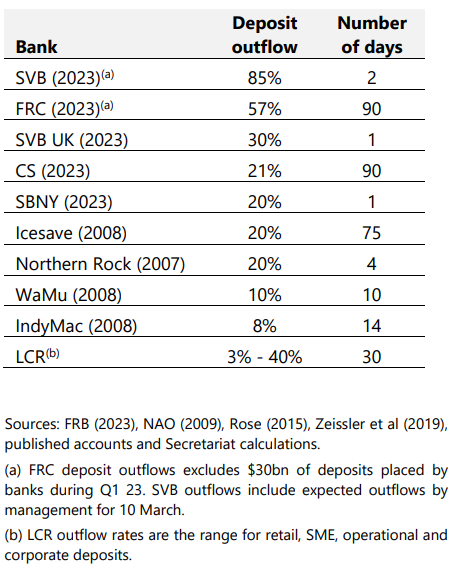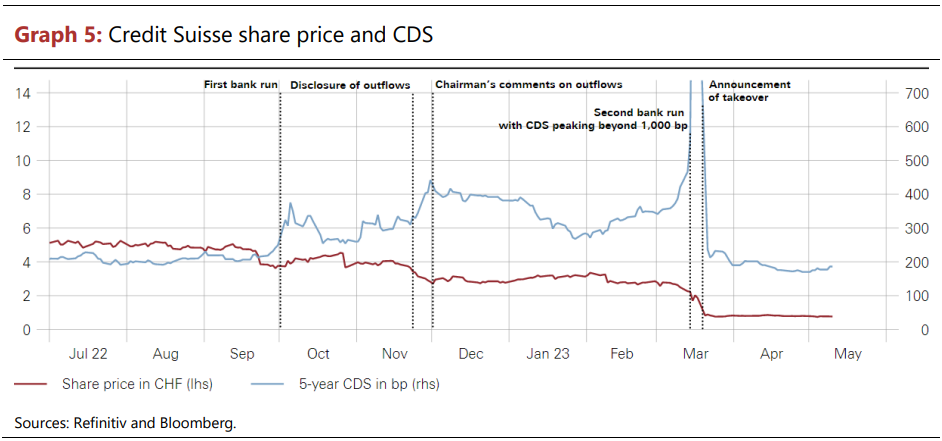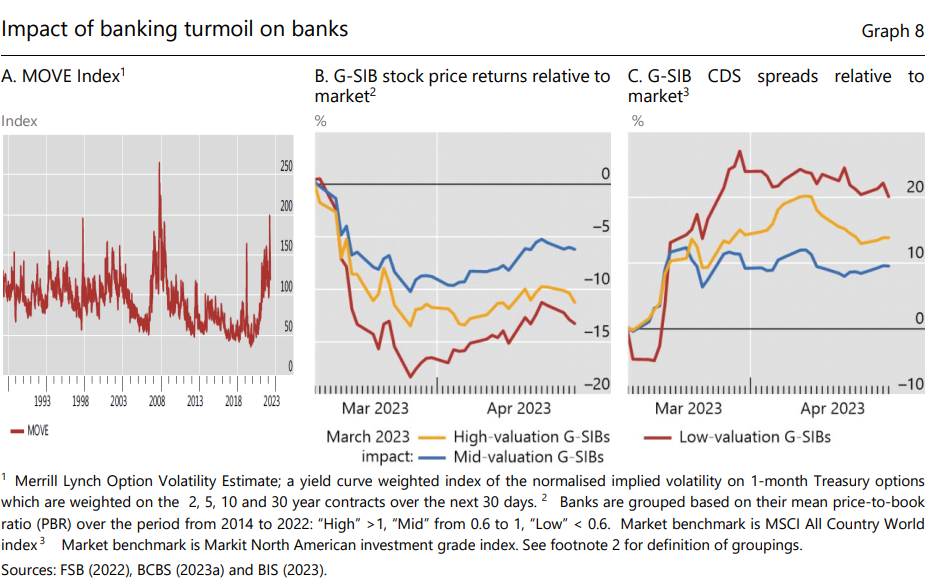Indicators of bank failures and how the Big Four are placed
Remember the global financial crisis (GFC)?
Rudd money sprinkling like confetti, short sellers having a fat time until regulators stepped in and banned the practice, and governments guaranteeing bank deposits.
According to a new report from the Bank of International Settlements (BIS), the turmoil in banks in March this year is similar - over the period from 8 to 19 March, four banks were shut down, put into receivership or rescued. This time saw the failures of Silicon Valley Bank (SVB), Signature Bank of New York (SBNY) and First Republic Bank (FRC), and the rescue of Credit Suisse (CS)). Another bank was closed on 1 May 2023.
One early indicator of problems in a bank is the volume and speed of deposit withdrawals by customers. The chart below shows the five banks from 2023 and compares those with four banks from 2008. The final statistic, Liquidity Coverage Ratio (LCR) and the rate of outflows shows how quickly the banks were put under stress

Another example is Credit Suisse. The chart below shows the impact of the news on key events.

And the evidence for turmoil more broadly can be seen in the three charts below: Move Index (option volatility estimates), stock prices for globally systemically important banks (G-SIB), and credit default spreads for the G-SIBs.

Three contributing factors
As the report comments, "The first and most important source of financial and operational resilience comes from banks’ own risk
management practices and governance arrangements."
And the signs they saw amongst the wreckage? The list is Risk Management 101 gone awry:
- fundamental shortcomings in basic risk management of traditional banking risks (such as interest rate risk and liquidity risk; and various forms of concentration risk)
- a failure to appreciate how the build-up of various individual risks were interrelated and could compound one another;
- inadequate and unsustainable business models, including an excessive focus on growth and short-term profitability (fuelled by remuneration policies), at the expense of appropriate risk management;
- a poor risk culture, as well as ineffective senior management and board oversight; and
- a failure to adequately respond to supervisory feedback and recommendations.
The second factor is banking supervision, the core audience for BIS and thus a sensitive point. However the factors that contributed here to the situation include
- the ability and willingness of supervisors not just to actively identify weaknesses in banks but also to take and enforce prompt actions;
- the need to continuously monitor exogenous and structural changes to the banking system and adapt supervisory approaches to overseeing risks, especially for banks that are rapidly growing in size or adopting novel business models.
An example is SVB. The report notes
"SVBFG had 31 open supervisory findings when it failed in March 2023, about triple the number observed at peer firms. The supervisory findings at SVBFG included core areas, such as governance and risk management, liquidity, interest rate risk management, and technology. Despite widespread evidence of foundational governance and risk-management issues, supervisors were slow to downgrade supervisory ratings or to ensure that SVBFG’s board and senior management took sufficient and immediate steps to compensate for those widespread weaknesses."
And the third factor was the Basel standards which they (unsurprisingly) saw as a point of strength, while reminding everyone that that system is not designed to produce zero failures, but rather to minimise the impact of that failure on the banking system more broadly.
The key takeaways
It's important to remember that Australian banks were okay during the GFC. In part, that was due to their own practices, but it also reflects APRA's management of the situation at that time. We also know that prudential regulators are networked and share information and findings.
We will hear the FY23 results from four banks over the next month: Bank of Queensland (ASX: BOQ) on 11 October, with Westpac (ASX: WBC) on 6 November and ANZ (ASX: ANZ) on 8 November and NAB (ASX: NAB) on 9 November.
And while the financial results and dividends are likely to be of keen interest to you, make sure you spend some time understanding the remuneration schemes, as well as disclosures about the actions of regulators. The banks' disclosures about risk management are also noteworthy.
We leave you with this final comment from the BIS as to matters discussed at its latest meeting on 4 October 2023
"The Committee discussed the outlook for the global banking system in the light of recent economic and financial market developments. While higher rates can support banks' net interest margins and related income, they can also expose vulnerabilities that have built up during the low-for-long era. These include risks stemming from potential credit losses related to rising debt service ratios for borrowers and the interest rate sensitivity of bank depositors. In addition, banks are exposed to the NBFI [non-bank financial institution] sector through a wide range of channels."